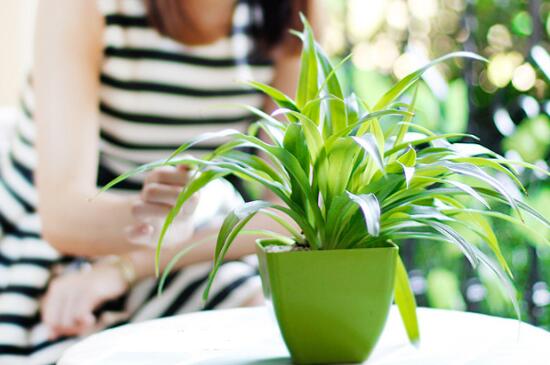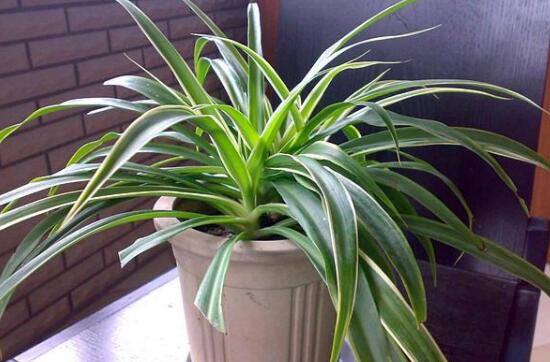How to propagate the green-leaf orchid, the diagram of the propagation method / ramet survival rate is high.
Green leaf orchid, one of the many hanging orchids, although it is not as beautiful as Phnom Penh and gold heart orchids, it is better than freshness and elegance. And the efficacy of green leaf orchid is very strong, especially the ability to absorb formaldehyde, strong amazing. Such plants are naturally propagated in large numbers, so how do green-leaf orchids reproduce? The following are three breeding methods of Cymbidium, follow the editor to have a look.
1. How to propagate, split / cuttage / sow

As the most common species of Cymbidium, the breeding method of Cymbidium is not difficult, we only need to be careful to raise it well. But if you are an old hand, in addition to raising, you should also master the breeding method of green leaf orchid, so that it is interesting to raise it. As for how to reproduce the green-leaf orchid, there are three main methods: ramet, cutting and sowing, and we continue to look at the specific operation.
2. Illustration of propagation methods of green leaf orchid (1) ramet propagation of green leaf orchid
Among the propagation methods of Cymbidium, the most convenient one is ramet. Methods: the healthy adult Cymbidium was taken out of the flowerpot, cleared the soil, cut part of the root system (with at least three stems), and then transplanted them to the new flowerpot for cultivation and maintenance.
(2) Cuttage propagation of Magnolia lanceolata
1. Cutting time
In addition to ramet, the most commonly used propagation method of Cymbidium is cutting. The best cutting time is in spring and autumn, when the green leaf orchid grows in the peak season, and the cutting survival rate is the highest.
2. Cutting substrate
According to the growth habits of Cymbidium, we should choose loose, breathable and permeable soil. In this regard, the editor recommends the use of vermiculite or coconut brick soil + perlite mixed soil.
3. Cuttings selection
Cutting is the most important link in the cutting propagation of Cymbidium. It can be said that if it is selected, more than half of the whole cutting process will be successful. Flower friends can cut the stolon on the well-growing green leaf orchid and cut it down 5-10 cm as cuttings.
4. Cuttings start
How to reproduce the green leaf orchid? After doing the above work, the cuttage propagation of Cymbidium can officially begin: insert the cuttings into the prepared soil, water them once, and then put them in a cool and ventilated place to wait for rooting, which will take root in 3 or 4 weeks.
(3) sowing and propagation of green leaf orchid.
After flowering, seeds can be obtained through some operations, so sowing can also be used for reproduction. Methods: in March every year, the seeds of Cymbidium were sown, covered with 0.5 cm of soil, and irrigated with appropriate amount of water. When the temperature is 15 ℃, it will take root and sprout in about 2 weeks, and wait for the seedlings to take shape before transplanting.
Generally speaking, the propagation of Cymbidium is not difficult, whether it is cutting, ramet, or sowing can take root and survive, but in terms of convenience, it is best to belong to ramet. Of course, the method is dead, people are alive, we can according to the actual situation, choose the method to breed. With regard to the breeding method of the green leaf orchid, the editor has introduced it here, hoping to bring help to everyone.
How to propagate, split and cuttage propagation of Cymbidium
How to reproduce Cymbidium, Cymbidium can be propagated by cutting and ramet, and the propagation time can be carried out at any time from spring to autumn. In addition, the adaptability of Cymbidium is very strong, and the survival rate of reproduction is high. Whether through ramet or cutting, it's easy to operate.
How to propagate Magnolia lanceolata 1. Cutting propagation method
The cutting time of Cymbidium can be carried out from spring to autumn. As long as the stolons with new buds are inserted into the soil, they can take root in about a week, transplant them in a pot in about 20 days, water them thoroughly and keep them in a cool place.
2. The method of ramet propagation
The split time of Cymbidium is also carried out from spring to autumn, and it is suggested that the pot change should be carried out together in spring. Flower friends can lift the plant out of the pot, remove the old soil and rotten root, cut the old root, and leave three stems on the split plant, and then transplant and culture separately.
Flower friends can also cut the clustered stems and leaves (in fact, the larvae of a new plant with leaves on the top and air roots at the bottom) on the stolon of Cymbidium, and plant it directly into a flowerpot.
How to propagate Magnolia lanceolata? two propagation methods (cuttings / ramets)
As a common indoor potted plant, the efficacy of Magnolia is very strong, it is not only good-looking, but also can absorb formaldehyde, but also has a good use in medicine. Such a plant is naturally very popular and has become the pursuit of many flower friends, so it has been multiplied in large numbers. So, how does Magnolia reproduce? The following are the two breeding methods of Cymbidium, follow the editor to have a look.
1. How to propagate, cuttings / ramets
As the best of the orchids, the breeding method of Magnolia is not easy, but it can be mastered perfectly as long as it takes a little thought. But if you are a veteran, in addition to raising, you should also know how to breed orchids, which can increase the fun of breeding. As for how to reproduce the orchid, there are two main methods: cutting and ramet, and we continue to look at the specific operation.
2. Two propagation methods of Magnolia lanceolata (1) Cuttage Propagation of Cymbidium
Magnolia is a common indoor potted plant, so cutting is the most commonly used method to propagate it. In the growing period, take a section of the branches of Magnolia, cuttage in the cultivation soil, careful maintenance can make the pot of Magnolia more than one pot. Next, let's take a look at the specific operation:
1. Cutting time
If you want to propagate Magnolia by cuttage, you must choose a good time. The golden orchid likes the warm environment, so spring and autumn is its peak growing season, and cutting is the best at this time.
2. Cutting substrate
Cuttings naturally need soil. According to the growth habits of Magnolia, we should choose loose, breathable and permeable soil. In this regard, the editor recommends the use of vermiculite or coconut brick soil + perlite mixed soil.
3. Cuttings selection
In the whole cutting propagation, the selection of cuttings is particularly important. You can plant a stolon on a well-growing plant, and then cut off the seedlings as cuttings, as shown in the picture above.
4. Cuttage start
After doing the above work, the cuttage of Magnolia can officially begin: insert the cuttings into the prepared soil, then water the soil thoroughly, so that the cuttings and the soil can be closely combined, and can be covered with plastic bags if possible.
(2) ramet propagation of Cymbidium chinensis.
In addition to cutting, ramet is also the most commonly used propagation method of Cymbidium. Methods: in March, on the well-growing Cymbidium, the isolated tufted old plants were selected for ramet cultivation, or the small plants on the stolon were cut off for cultivation. After the appropriate amount of fertilization, and then the flowerpot control in the indoor sunny place, careful maintenance can be.
Generally speaking, it is not difficult for Cymbidium to reproduce. Cuttings and ramets can survive, but in terms of survival rate, cutting is the best. Of course, the method is dead, people are alive, we can according to the actual situation, choose the method to breed. With regard to the breeding method of Magnolia, this is the end of the editor's introduction, hoping to bring help to everyone.
- Prev

How to propagate Phnom Penh, three propagation methods / detailed cuttage diagram of Phnom Penh.
As an extraordinarily beautiful existence in the orchid, the efficacy of Phnom Penh is very strong, it is not only good-looking, but also can absorb formaldehyde. Such a plant is naturally raised at home by a large number of flower friends, and it is therefore multiplied in large numbers. So, how do Phnom Penh orchids breed? Here are three breeding methods for Phnom Penh.
- Next

How to grow stevia
How to grow stevia
Related
- Fuxing push coffee new agricultural production and marketing class: lack of small-scale processing plants
- Jujube rice field leisure farm deep ploughing Yilan for five years to create a space for organic food and play
- Nongyu Farm-A trial of organic papaya for brave women with advanced technology
- Four points for attention in the prevention and control of diseases and insect pests of edible fungi
- How to add nutrient solution to Edible Fungi
- Is there any good way to control edible fungus mites?
- Open Inoculation Technology of Edible Fungi
- Is there any clever way to use fertilizer for edible fungus in winter?
- What agents are used to kill the pathogens of edible fungi in the mushroom shed?
- Rapid drying of Edible Fungi

